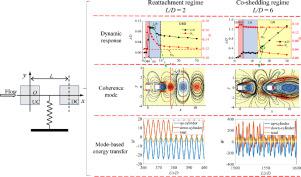International Journal of Mechanical Sciences ( IF 7.3 ) Pub Date : 2022-06-21 , DOI: 10.1016/j.ijmecsci.2022.107468 Hongfu Zhang , Lei Zhou , Tim K.T. Tse

|
Two rigidly coupled cylinders are commonly available in engineering practices, which are always subjected to flow-induced vibration (FIV) with large oscillating amplitude due to the complex gap flow. However, their FIV features and the underlying mechanism have not been clearly understanded. In this study, the FIV of two rigidly coupled square cylinders in a tandem arrangement was numerically investigated for Reynolds numbers 100 and 200 and gap L/D = 2.0 and 6.0 in a two-dimensional framework. The dynamic response and flow structures are first studied. Mode-based energy transfer analysis was developed based on proper orthogonal decomposition. The energy transfer between the cylinders and the coherence modes was then analyzed to uncover the underlying mechanism of the FIV. The results reveal that the soft lock-in phenomenon was observed for all cases. When the gap L/D = 2.0, the dynamic response is always smaller than a stationary cylinder and all the wake structures show “2S” modes, which results from the stabilized effects of the upstream cylinder. At L/D = 6.0, the oscillating amplitude is much higher than that of a single square cylinder, due to the vigorous interaction between gap flow and the cylinders. As Reynolds number increased from 100 to 200, both vortex-induced vibration (VIV) and galloping co-exist, while the VIV response was reduced. Concerning the energy transfer, for L/D = 2.0, the first mode pair induced by Karman vortex shedding dominated the wake flow. The primary mode governed by UC stabilized the vibration, while the second mode tended to excite the FIV. For L/D = 6.0 in the galloping branch, the first two modes belonged to the vortex-induced modes, and the third mode represented the galloping mode. The galloping mode tended to excite the flow-induced vibration, while it was contrary for the vortex-induced modes.
中文翻译:

两个刚性耦合串联气缸流激振动的基于模态的能量传递分析
工程实践中常见的两个刚性耦合圆柱体,由于复杂的间隙流动,总是受到具有大振荡幅度的流激振动(FIV)的影响。然而,它们的 FIV 特征和潜在机制尚未被清楚地了解。在这项研究中,对雷诺数 100 和 200 以及间隙L/D的两个刚性耦合方形圆柱串联排列的 FIV 进行了数值研究 = 2.0 和 6.0 在二维框架中。首先研究动态响应和流动结构。基于模式的能量转移分析是基于适当的正交分解开发的。然后分析圆柱体和相干模式之间的能量传递,以揭示 FIV 的潜在机制。结果表明,在所有情况下都观察到了软锁定现象。当间隙L/D = 2.0 时,动态响应总是小于静止圆柱体,并且所有尾流结构都显示“2S”模式,这是上游圆柱体稳定效应的结果。在L/D = 6.0,由于间隙流与圆柱体之间的强烈相互作用,振荡幅度远高于单个方形圆柱体的振荡幅度。随着雷诺数从 100 增加到 200,涡激振动 (VIV) 和舞动共存,而 VIV 响应降低。关于能量转移,对于L/D = 2.0,由卡门涡旋脱落引起的第一模式对主导尾流。由 UC 控制的主要模式稳定了振动,而第二种模式倾向于激发 FIV。舞动支路L/D = 6.0 时,前两种模态属于涡激模态,第三种模态代表舞动模态。舞动模式倾向于激发流激振动,而涡激模式则相反。



























 京公网安备 11010802027423号
京公网安备 11010802027423号